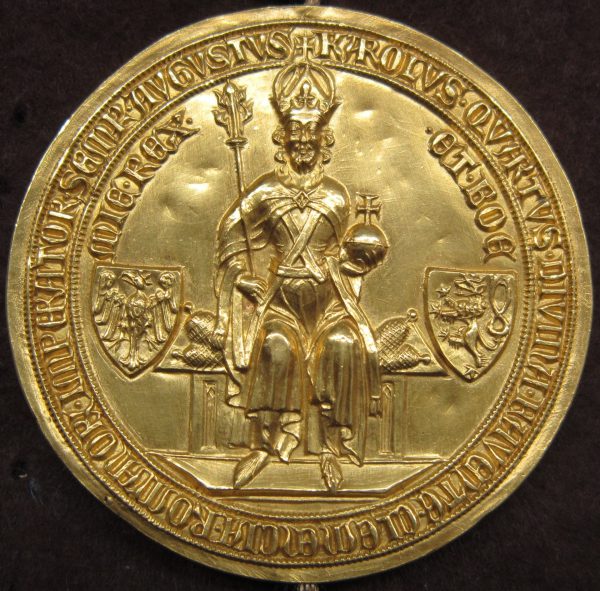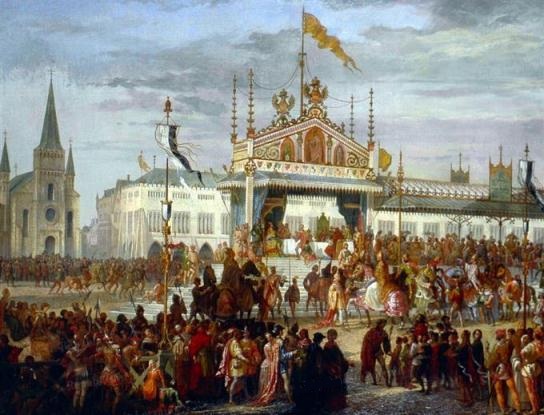
Close-up of the Trier copy of the golden bull in the main state archive Stuttgart.
On December 25, 1356, the final chapters of the Golden Bull were decreed by the Imperial Diet at Nuremberg and Metz headed by the Emperor Charles IV. The Golden Bull fixed, for a period of more than four hundred years, important aspects of the constitutional structure of the Holy Roman Empire. It mainly regulated the modalities of election and the coronation of the Roman-German kings and emperors by the electors until the end of the Old Empire in 1806. The Golden Bull is the most important constitutional document of the medieval empire.
Origins
A golden bull or chrysobull originally was a decree issued by Byzantine Emperors and later by European monarchs during the Middle Ages and Renaissance, most notably by the Holy Roman Emperors. The term was originally coined for the golden seal (the bulla aurea), attached to the decree, but came to be applied to the entire decree.
The Golden Bull of 1356
Probably the most important of the Golden Bulls is the Golden Bull of 1356, which fixed important aspects of the constitutional structure of the Holy Roman Empire for more than 400 years. The Holy Roman Empire was a multi-ethnic complex of territories in Central Europe that developed during the Early Middle Ages and continued until its dissolution in 1806. On 25 December 800, Pope Leo III crowned the Frankish king Charlemagne as Emperor [2], reviving the title in Western Europe, more than three centuries after the fall of the Western Roman Empire. The title continued in the Carolingian family until 888. The title was revived in 962 when Otto I was crowned emperor [3], fashioning himself as the successor of Charlemagne and beginning a continuous existence of the empire for over eight centuries.
The Holy Roman Empire
The precise term “Holy Roman Empire” was not used until the 13th century, but the concept of translatio imperii, the notion that he – the sovereign ruler – held supreme power inherited from the emperors of Rome, was fundamental to the prestige of the emperor. The office of Holy Roman Emperor was traditionally elective, although frequently controlled by dynasties. The German prince-electors, the highest-ranking noblemen of the empire, usually elected one of their peers as “King of the Romans”, and he would later be crowned emperor by the Pope.
Electing the King of the Romans
Though the election of the King of the Romans by the chief ecclesiastical and secular princes of the Holy Roman Empire was well established, disagreements about the process and papal involvement had repeatedly resulted in controversies, most recently in 1314 when Louis of Bavaria and Frederick of Austria had been elected by opposing sets of electors. Louis, who had eventually subdued his rival’s claim on the battlefield, made a first attempt to clarify the process in the Declaration of Rhense of 1338, which renounced any papal involvement and had restricted the right to choose a new king to the prince-electors. The Golden Bull, promulgated by Louis’s successor and rival, Charles IV, was more precise in several ways.

Golden Bull decree of 1356 issued by the Reichstag assembly in Metz. Painting by Auguste Migette, ca 1850.
The Prince-Electors
Firstly, the Bull explicitly named the seven Prince-electors (Kurfürsten) who were to choose the King and also defined the Reichserzämter, their (largely ceremonial) offices at court. Secondly, the principle of majority voting was explicitly stated for the first time in the Empire. The Bull prescribed that four (out of seven) votes would always suffice to elect a new King; as a result, three Electors could no longer block the election. Thirdly, the Electoral principalities were declared indivisible, and succession to them was regulated to ensure that the votes would never be divided. Finally, the Bull cemented a number of privileges for the Electors, confirming their elevated role in the Empire.
The bull regulated the whole election process in great detail, listing explicitly where, when, and under which circumstances what should be done by whom, not only for the prince-electors but also (for example) for the population of Frankfurt, where the elections were to be held, and also for the counts of the regions the prince-electors had to travel through to get there. The decision to hold the elections in Frankfurt reflected a traditional feeling dating from East Frankish days that both election and coronation ought to take place on Frankish soil. However, the election location was not the only specified location; the bull specified that the coronation would take place in Aachen, and Nuremberg would be the place where the first diet of a reign should be held.
The Role of the Pope
The pope’s involvement with the Golden Bull of 1356 was basically nonexistent, which was significant in the history of relations between the popes and the emperors. When Charles IV laid down procedure for electing a King of the Romans, he mentioned nothing about receiving papal confirmation of the election. However, Pope Innocent VI did not protest this because he needed Charles’s support against the Visconti. Pope Innocent continued to have good relations with Charles IV after the Golden Bull of 1356 until the former’s death in 1362.
Towards Secular and Spiritual Sovereignty
The Golden Bull documents, formalizes and codifies a centuries-old practice and development towards territorialization. The establishment of both the secular and spiritual sovereignty of the country from the 11th to the 14th century and, at the same time, the king’s creeping loss of power in the course of territorialization are laid down. Some historians speak of the conflict between “central power” and “centrifugal forces” in the course of the development from a feudal association of individuals to an administrative-legal state.
Due to the extensive sovereignty of the individual territories, no central state arose in the territory of the Holy Roman Empire, such as in England or France, which reigned from a powerful monarchic court and thus a political and cultural centre. There is no linguistic uniformity and standardization, but the respective territories retain their regions and develop largely autonomously. The territories build up their own universities, which teach independently of each other and have an important function in attracting special “state officials”. Territorialization continued in the following centuries, the division of Germany into independent territories was sealed in the Peace of Westphalia of 1648, and the central power lost even more authority until it was formally terminated in 1806.[7]
Electoral College of the Holy Roman Empire: Origins and development., [6]
References and Further Reading:
- [1] Golden Bull in the Middle Ages, at Medieval – Life in the Middle Ages
- [2] Charlemagne and the Birth of Europe, SciHi Blog, December 25, 2012.
- [3] Otto the Great – Founder of the Holy Roman Empire, SciHi Blog, Novemeber 23, 2012.
- [4] The complete Golden Bull of 1356, translated into English.
- [5] The Golden Bull of 1356 at Wikidata
- [6] Electoral College of the Holy Roman Empire: Origins and development, Terillian @ youtube
- [7] The Peace of Westphalia and the End of the Thirty Year’s War, SciHi Blog
- [8] Timeline of Political Charters, via Wikidata and DBpedia





